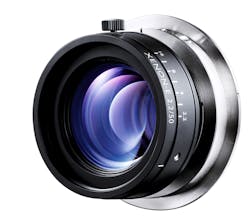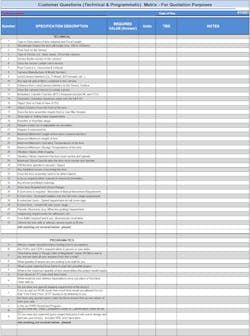Engineers are a special breed known for their love of precision and efficiency. So, why is it then that a growing number of the emails and phone calls I receive inquiring about lenses for their imaging systems go something like this:
Hi, Stuart:
Can you please provide a quote for a lens for an immersion microscope?
Sincerely,
X
Can I what? Do you think I am clairvoyant?
I’m not being dramatic. I really got this request, and I’m getting them more and more often: requests for lenses for imaging systems without any forethought given to the lens specifications, performance requirements, and system and design context that any intelligent person would need to know to fulfill the request.
This is a problem that has begun to snowball, and I want to stop it. Consider this article a large, snowball-stopping brick wall—one built from the heart, more than 40 years in optical lens design and fabrication, and a serious concern for the next generation of optical engineers.
Why?
So, how did it come to this? Why is it that fewer and fewer engineers are doing their homework before they place their lens order?
Perhaps it’s a product of Amazon and McDonald’s culture—lightning fast fulfillment of orders that seems to happen by magic. Maybe, but in those cases, the people doing the ordering know what they want. When, instead, you are asking me to figure out what you want, something else is at work.
I have three theories, and I’d welcome your thoughts on them.
First, there is the folly of youth theory—it’s simply a case of a new engineer making a rookie mistake. If that’s the case, listen to me: do your homework before calling or emailing asking for lens help. But before you think I am picking on young engineers, please know that I am not, because young engineers are quick learners, and I am always happy to help them. Let’s get to theories two and three, which throw the lasso around those with more experience.
My second theory is that they have simply grown lazy. “Come on, optical lens solution provider, it’s just a lens—figure it out.”
Figure it out? Just a lens? The lens is going to dictate the performance of your optical system. I’d be happy to “figure it out” with you, because getting the lens right is a collaboration. It takes two, and you are half of the equation. If you provide zero effort, and I put in 100 percent, we still get a 50. That may pass on a curve in college, but it will torpedo your optical system in real life and cost your company valuable time, resources, and dollars. It may also cost you your reputation.
My third theory is that even experienced optical engineers forget sometimes. So, let this article serve as a reminder: the more specificity you can give your lens provider up front, the more efficiently your optical system will get built and, ultimately, perform.
Sunday Car Mechanic Syndrome
So, I’m being a little playful here in hopes that you might recognize some of yourself or your colleagues in these scenarios. But, the problem I am describing is very real, very serious, and becoming more and more pervasive.
What happens when a lens solution provider doesn’t get the specificity it needs to fulfill a lens request? I call it the Sunday car mechanic syndrome. Sure, I don’t mind noodling around with car repairs on a given weekend. It’s part of my tinkering nature. If a fix doesn’t work brilliantly—it rarely does—I can tinker with it later.
But, is that what you want for your lenses? Your provider gives you a lens based only on its best guess because you provided such little guidance; it doesn’t work so you send it back for a fix with a little more direction; and you pass it back and forth until it’s right?
That’s a fool’s errand—with a fool on each side of the exchange. Remember: there is an optical system at stake here. Two engineers should be able to converse technically and get the lens right the first time 100 percent of the time without ambiguity. Here’s how.
There’s a Matrix for That
Optical systems take on myriad shapes and forms to accomplish a variety of very specific purposes, each of which requires a lens, or lenses, crafted to exacting specifications.
When I have you on the phone or am conversing with you via email, I need to use that opportunity to extract as much information from you as possible so I can recommend, and deliver, the best lens for your system. To that end, I have my own “Top 10” list of questions you should expect me to ask, and that you should be ready in advance to answer:
Stu’s Top 10 Optical System Spec Questions for Lens Designation
Please tell me in as much detail as possible, what is the:
- Object Size (l, w, h) or Field of View (FOV)?
- Image (area or linear, l/w/h, # of pixels)?
- Sensor Model inside the camera (color, BW, pixel size, IR block filter)?
- Wavelength Region (mono, visible, Near IR)?
- Camera Mount (C-Mount, F-Mount, etc.)?
- Object Distance (Working Distance)?
- Black Box Size (Lens: maximum diameter, length)?
- System Resolution (Object Space)?
- Object Contrast?
- System Environment (temperature range, vibration, dust)?
I think you get the point. The funny thing is this isn’t even close to exhausting all my questions. After decades of interacting with engineers to develop and deliver the world’s best lenses, I have more than 50, and in the spirit of helping you contribute to developing and delivering the world’s best optical systems, I am going to share them with you.
Welcome to “The Matrix.” Fill it in with as much information as you can, understanding I never expect all of the questions to be answered:
Three Paths to Fulfillment
If my Top 10 Questions and Technical Matrix are the “how” of getting you to the right lens for your optical system and eliminating the wasted time, money, and inefficiency involved when you ask your lens solution provider to be clairvoyant, I’d also like to give you more detail about “why” I, or any other lens purveyor, need that information. The key reason is there are three paths to fulfilling your lens solution request, each of which has significant time, budget, and performance implications for your system. Once I have the information I need to really understand your lens needs, I have to choose a path forward:
Commercial Off-the-Shelf (COTS) Lens: This is the easiest solution. The closest to the Amazon scenario I outlined earlier. You have a need. I have a lens in stock that meets most, if not all, of the specifications of your system. I can give you a quote, and if you like it, bingo, you’ve got your lens!
COTS Mod Lens: If an off-the-shelf standard commercial design/lens cannot satisfy your requirements, the best approach is to see if the lens manufacturer can modify an existing design to meet your needs. Because extra work is required, this approach will cost more than buying something off the shelf and will take more time. In my experience, depending on the number of modifications, projects of this sort can take 8-12 weeks for the development of a prototype lens, with serial production of the new lens starting 12-16 weeks from prototype approval. In the end, you get the high-performing lens you need without breaking the bank.
Custom Lens: Sometimes there is simply no way to make all the modifications necessary to an off-the-shelf lens to get it the needed specifications. Then you have a tough decision—one that likely leads to the development of a custom lens. When a new lens needs to be designed from scratch to meet your optical-system needs, it is good to know going in what kind of effort will be entailed and timeline required:
- Quote Lead Time
- Rough Order of Magnitude (ROM) = 4-8 weeks
- Firm Fixed Price (FFP) = 10-16 weeks
- Prototype (small batch) development and delivery = 16-24 weeks after receipt of order (ARO)
- Serial production = 16-24 weeks after customer approval
The custom lens route is obviously going to be more time-consuming and expensive than the other options, but sometimes that’s the only way to get it right. In my experience, the only way to cost-justify this approach is to make sure you can order more than 50 of these lenses.
In each of these paths to optical-lens selection and fulfillment, I hope you can see the impact of missing, erroneous, or half-baked lens specifications. When we don’t have a crisp, intelligent, and detailed exchange of information up front in the lens selection process, we quickly devolve into a garbage in, garbage out scenario. Believe me, you don’t want that.
Don’t Be That Customer
I’m reminded of an experience I had early on in my career with a customer, one that has really stuck with me. He called me, and his impatience was palpable. He was with a big corporation, a Fortune 500 company, and told me he was an optical engineer in need of a 50-mm lens for his inspection system.
I didn’t have my “Top 10 Questions” fully developed at the time, but they were already coming together in my mind. So I started asking—what is the system looking at?, what is the object length?—and I got the hand. “Look, I’m in a hurry, just send me the lens.”
So I did.
About two months later, I got an email from the customer. Any guesses as to what it said?
“That lens was awful.”
So, I called him back. I knew the lens wasn’t at fault, in fact it was one of our all-time best- performing lenses. But it clearly wasn’t the right lens for this job.
After a little digging, the client revealed the details of his optical system, and it was a very intricate one that required exacting performance – counting individual pieces of paper as they came off the production line and were stacked into reams, then packaged for delivery. Providing the right lens for this environment without any information about pixel size, object distance and size, etc. was hopeless at best.
Don’t be that customer. You are so much better than that. Review the matrix, do your homework, and get ready to collaborate to make lens selection for your optical system a value-creating step in your process that gets you—and the systems you touch—known for excellence.
About the Author
Stuart Singer
Stuart Singer is the CEO of Schneider Optics (Hauppauge, NY, USA).

